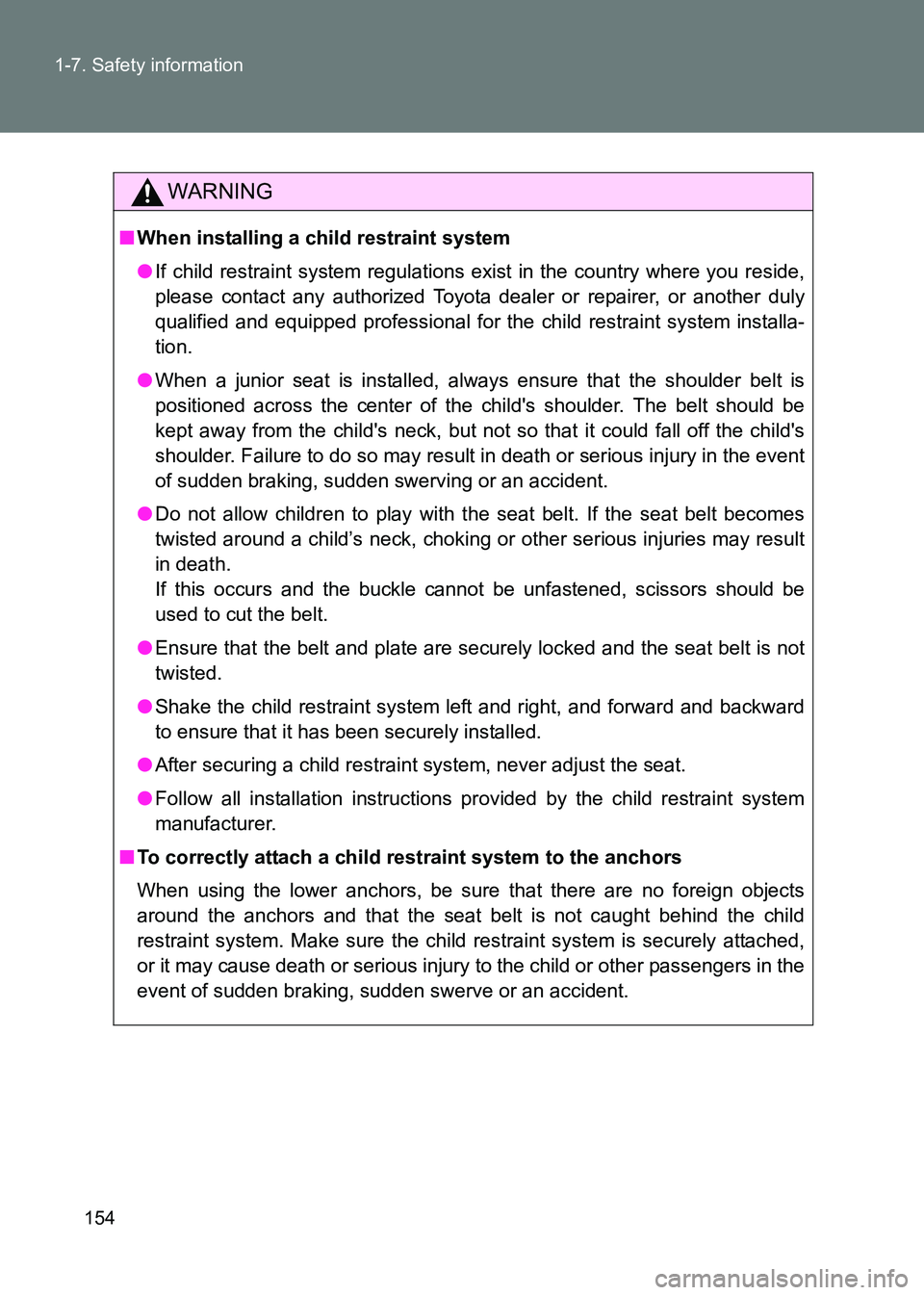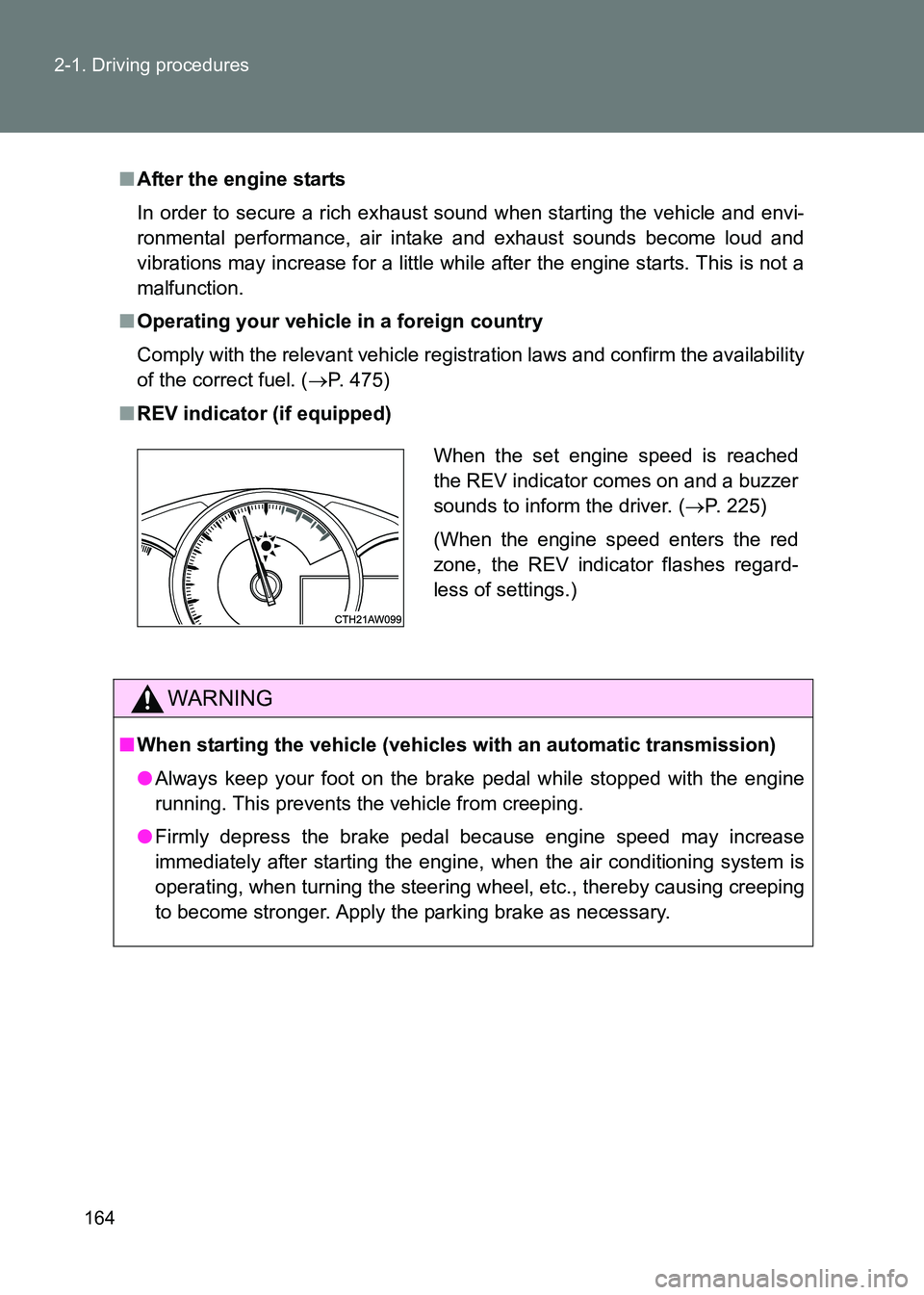Page 143 of 505
143
1-7. Safety information
1
Before driving
86_EE (OM18071E)
WARNING
■
Using a child restraint system
The use of a child restraint system not suitable for the vehicle may not prop-
erly secure the infant or child. It may result in death or serious injury (in the
event of sudden braking or an accident).
■ Child restraint precautions
●For effective protection in automobile accidents and sudden stops, a child
must be properly restrained, using a seat belt or child restraint system
depending on the age and size of the child. Holding a child in your arms is
not a substitute for a child restraint system. In an accident, the child can be
crushed against the windshield, or between you and the vehicle's interior.
● Toyota strongly urges the use of a proper child restraint system that con-
forms to the size of the child, installed on the rear seat. According to acci-
dent statistics, the child is safer when properly restrained in the rear seat
than in the front seat.
Page 144 of 505

144
1-7. Safety information
86_EE (OM18071E)
WARNING
■
Child restraint precautions
●Never use a rear-facing child restraint system on the front passenger seat
when the airbag manual on-off switch is on. ( →P. 155)
In the event of an accident, the force of the rapid inflation of the front pas-
senger airbag can cause death or serious injury to the child.
● A forward-facing child restraint system should be allowed to be installed
on the front passenger seat only when it is unavoidable. Always move the
seat as far back as possible, because the front passenger airbag could
inflate with considerable speed and fo rce. Otherwise, the child may be
killed or seriously injured.
● Do not allow the child to lean his/her head or any part of his/her body
against the door or the area of the seat , front and rear pillars or roof side
rails from which the SRS side airbags or SRS curtain shield airbags deploy
even if the child is seated in the child restraint system. It is dangerous if
the SRS side airbags and curtain shield airbags inflate, and the impact
could cause death or serious injury to the child.
● Make sure you have complied with all installation instructions provided by
the child restraint manufacturer and that the system is properly secured. If
it is not secured properly, it may cause death or serious injury to the child
in the event of a sudden stop, sudden swerve or an accident.
■ When children are in the vehicle
Do not allow children to play with the seat belt. If the seat belt becomes
twisted around a child’s neck, it may lead to choking or other serious injuries
that could result in death.
If this occurs and the buckle cannot be unfastened, scissors should be used
to cut the belt.
■ When the child restraint system is not in use
●Keep the child restraint system properly secured on the seat even if it is
not in use. Do not store the restraint unsecured in the passenger compart-
ment.
● If it is necessary to detach the child restraint system, remove it from the
vehicle or store it securely in the tr unk. This will prevent it from injuring
passengers in the event of a sudden stop, sudden swerve or an accident.
Page 152 of 505
152
1-7. Safety information
86_EE (OM18071E)
WARNING
■
When installing a child restraint system
Follow the directions given in the child restraint system installation manual
and fix the child restraint system securely in place.
If the child restraint system is not correctly fixed in place, the child or other
passengers may be injured or even killed in the event of sudden braking,
sudden swerving or an accident.
●If the driver's seat interferes with the
child restraint system and prevents it
from being attached correctly, attach
the child restraint system to the right-
hand rear seat (left-hand drive vehicles)
or the left-hand rear seat (right-hand
drive vehicles).
● Adjust the front passenger seat so that
it does not interfere with the child
restraint system.
● When installing a forward-facing child
restraint system on the front passenger
seat, move the seat as far back as pos-
sible.
Failure to do so may result in death or
serious injury if the airbags deploy
(inflate).
Page 153 of 505
153
1-7. Safety information
1
Before driving
86_EE (OM18071E)
WARNING
■
When installing a child restraint system
●Never use a rear-facing child restraint
system on the front passenger seat
when the airbag manual on-off switch is
on. ( →P. 155)
The force of the rapid inflation of the
front passenger airbag can cause death
or serious injury to children in the event
of an accident.
● There is a label(s) on the passenger
side sun visor, indicating it is forbidden
to attach a rear-facing child restraint
system to the front passenger seat.
Details of the label(s) are shown in the
illustration below.
Page 154 of 505

154
1-7. Safety information
86_EE (OM18071E)
WARNING
■
When installing a child restraint system
●If child restraint system regulations exist in the country where you reside,
please contact any authorized Toyota dealer or repairer, or another duly
qualified and equipped professional for the child restraint system installa-
tion.
● When a junior seat is installed, always ensure that the shoulder belt is
positioned across the center of the child's shoulder. The belt should be
kept away from the child's neck, but not so that it could fall off the child's
shoulder. Failure to do so may result in death or serious injury in the event
of sudden braking, sudden swerving or an accident.
● Do not allow children to play with the seat belt. If the seat belt becomes
twisted around a child’s neck, choking or other serious injuries may result
in death.
If this occurs and the buckle cannot be unfastened, scissors should be
used to cut the belt.
● Ensure that the belt and plate are securely locked and the seat belt is not
twisted.
● Shake the child restraint system left and right, and forward and backward
to ensure that it has been securely installed.
● After securing a child restraint system, never adjust the seat.
● Follow all installation instructions provided by the child restraint system
manufacturer.
■ To correctly attach a child restraint system to the anchors
When using the lower anchors, be sure that there are no foreign objects
around the anchors and that the seat belt is not caught behind the child
restraint system. Make sure the child restraint system is securely attached,
or it may cause death or serious injury to the child or other passengers in the
event of sudden braking, sudden swerve or an accident.
Page 157 of 505

157
1-7. Safety information
1
Before driving
86_EE (OM18071E)
■
Airbag manual on-off indicator information
●The front passenger’s front airbag ON and OFF indicators shows you the
status of the front passenger’s SRS front airbag. When the engine switch
is turned to the “ON” position (vehicles without a smart entry & start sys-
tem) or the “ENGINE START STOP” switch is turned to IGNITION ON
mode (vehicles with a smart entry & start system), both the ON and OFF
indicators illuminate while the system is checked, after which both indica-
tors turn off. After that, “ON” or “OFF” on the ON-OFF indicator will be
illuminated according to the position of the airbag manual on-off switch.
● If any of the following problems occur, it is possible that there is a mal-
function in the system. Have the vehicle inspected by any authorized
Toyota dealer or repairer, or another duly qualified and equipped profes-
sional.
• Neither “ON” nor “OFF” comes on.
• The indicator light does not change when the airbag manual on-off switch is switched to “ON” or “OFF”.
WARNING
■When installing a child restraint system
For safety reasons, always install a child restraint system in a rear seat. In
the event that the rear seat cannot be used, the front seat can be used as
long as the airbag manual on-off system is set to “OFF”.
If the airbag manual on-off system is left on, the strong impact of the airbag
deployment (inflation) may cause serious injury or even death.
■ When a child restraint system is not installed on the front passenger
seat
Ensure that the airbag manual on-off system is set to “ON”.
If it is left off, the airbag may not deploy in the event of an accident, which
may result in serious injury or even death.
Page 159 of 505

2When driving
159
86_EE (OM18071E)
2-1. Driving proceduresDriving the vehicle ............ 160
Engine (ignition) switch (vehicles with a
smart entry &
start system) ................... 174
Engine (ignition) switch (vehicles without a
smart entry &
start system) ................... 183
Automatic transmission .... 186
Manual Transmission ....... 193
Turn signal lever ............... 197
Parking brake ................... 198
Horn .................................. 199
2-2. Instrument cluster Gauges and meters .......... 200
Indicators and warning lights ............................... 204
Multi-information display (monochrome display) .... 210
Multi-information display (color display) ................. 215 2-3. Operating the lights and
windshield wipers
Headlight switch................ 231
Fog light switch ................. 237
Windshield wipers and washer ............................ 238
2-4. Using other driving systems
Cruise control.................... 241
Driving assist systems ...... 246
Hill-start assist control....... 253
2-5. Driving information Cargo and luggage ........... 257
Winter driving tips ............. 259
Trailer towing .................... 263
Page 164 of 505

164
2-1. Driving procedures
86_EE (OM18071E)
■
After the engine starts
In order to secure a rich exhaust sound when starting the vehicle and envi-
ronmental performance, air intake and exhaust sounds become loud and
vibrations may increase for a little while after the engine starts. This is not a
malfunction.
■ Operating your vehicle in a foreign country
Comply with the relevant vehicle registration laws and confirm the availability
of the correct fuel. ( →P. 475)
■ REV indicator (if equipped)
WARNING
■When starting the vehicle (vehicl es with an automatic transmission)
● Always keep your foot on the brake pedal while stopped with the engine
running. This prevents the vehicle from creeping.
● Firmly depress the brake pedal because engine speed may increase
immediately after starting the engine, when the air conditioning system is
operating, when turning the steering wheel, etc., thereby causing creeping
to become stronger. Apply the parking brake as necessary.
When the set engine speed is reached
the REV indicator comes on and a buzzer
sounds to inform the driver. ( →P. 225)
(When the engine speed enters the red
zone, the REV indicator flashes regard-
less of settings.)